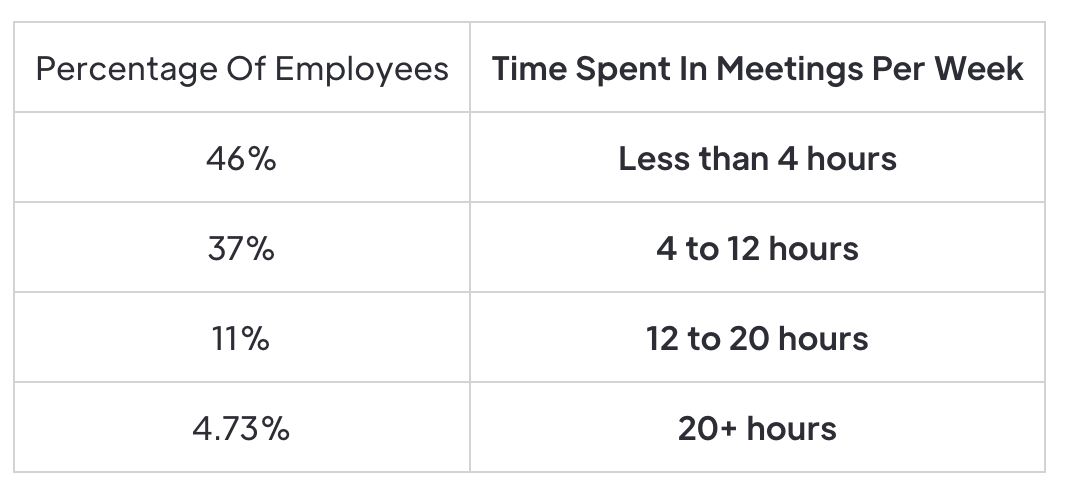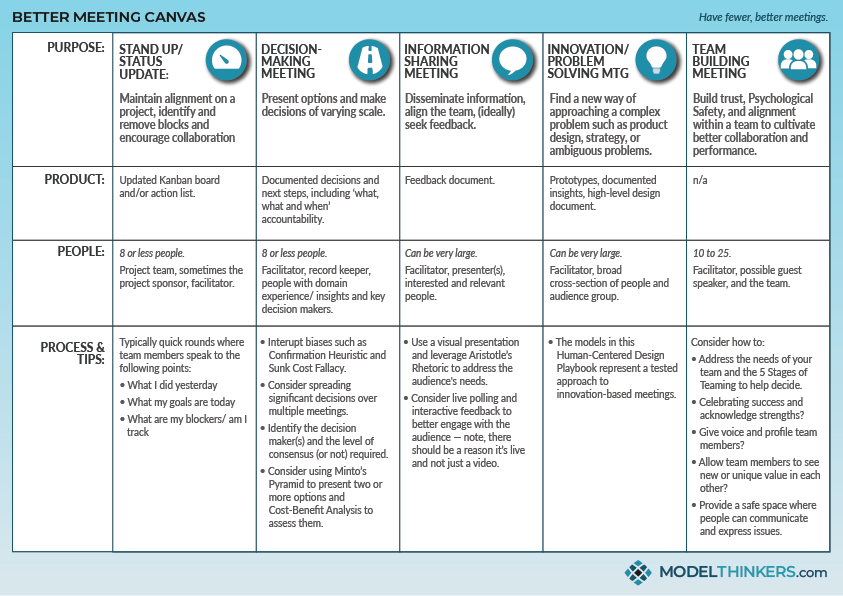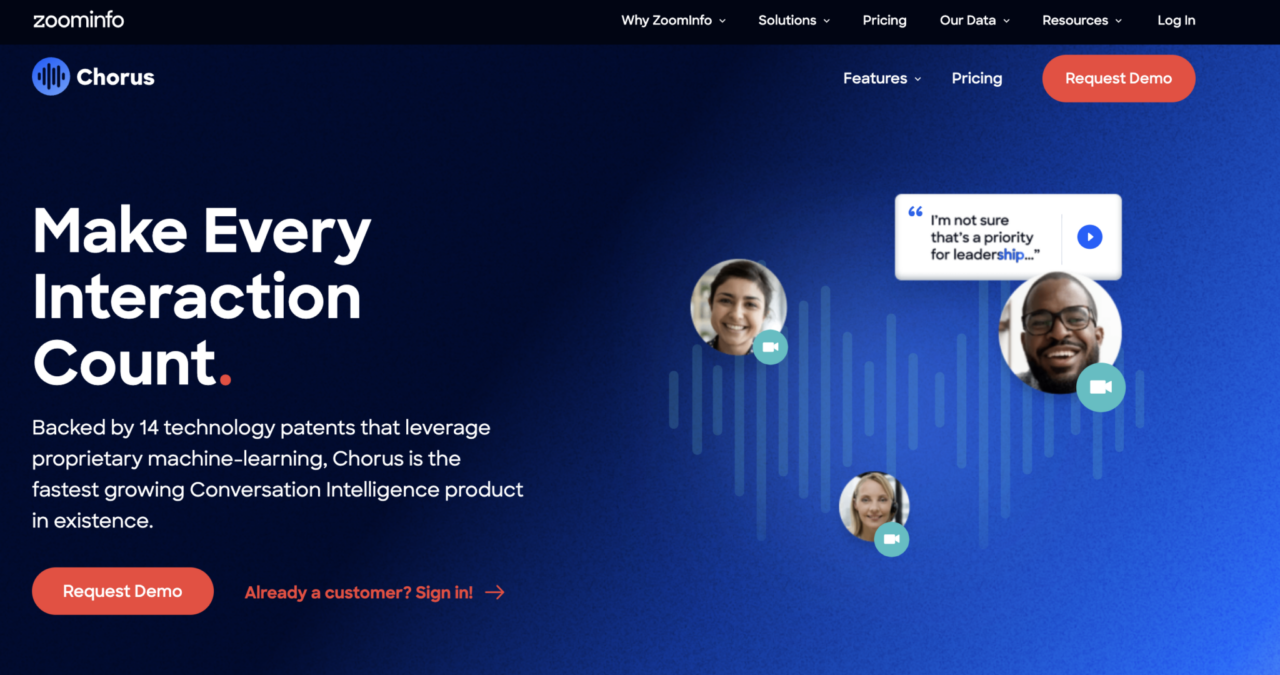A lot of company meetings are time wasters. Odds are that you’ve been in one or more meetings that left you with as many questions as you started with.
But they don’t all have to be that way. Staying focused and on-agenda are both crucial components for running and participating in productive meetings.
In this post, we will discuss the importance staying laser-focused and intentional with your meetings by providing you with practical strategies to optimize your productivity during a company meeting.
The Value of Running Effective Marketing Meetings
Running a productive company meeting plays a vital role in maximizing team performance. But there is definitely a point where you can reach critical mass and then the time spent in a meeting will yield diminishing returns.
For marketing teams, fostering collaboration and exchanging ideas is especially critical. But every meeting you jump into ought to have very clear goals and leave you and everyone involved with explicit action items that pertain to the contents of the meeting.
Unless it’s a freeform brainstorming session, meetings should strive to be short and to the point.
Get in. Contribute wisely. And get out of. You and your teammates need to return to actually fulfilling the discussion you laid out in the meeting.
A Company Meeting That Should Have Been an Email
We won’t dig into all of the datapoints in this post, but you can see a bunch of valid observations on how meetings can waste your time here:

One of the most cost-conservative and time-saving questions you can ask yourself is whether or not a proposed meeting is even necessary to begin with.
Ask yourself: “Can what we’re trying to communicate and resolve be sufficiently handled by way of an email chain?”
If you can summarize the point of an entire meeting into a few hundred words in an email, you may be able to save you and your team large shares of time that would have been spent in a meeting.
Check out this handy flowchart to help guide you in the decision process on whether or not your next meeting should happen:

Preparing for a Productive Marketing Meeting
Preparing for a productive marketing meeting requires careful and thorough preparation. It’s not enough to simply gather a group of individuals in a room and hope for the best.
To truly make the most of these collaborative sessions, you need to lay a rigid ring of boundaries. This means sharing with all participants well in advance:
- the meeting objectives
- relevant data
- problems to solve
- potential solutions
When participants have the opportunity to delve into the provided materials, they can come to the meeting armed with valuable insights and fresh perspectives. This advanced preparation eliminates the need for time-consuming explanations and allows the meeting to jump right into the heart of the matter.
Encouraging attendees to ponder the best approaches and consider potential roadblocks before the meeting also fosters a sense of ownership and accountability. Each person becomes an active participant in shaping the discussion and contributing to the collective problem-solving process. Their thoughts and ideas carry weight and significance, as they have had time to carefully reflect on the issues at hand.
When individuals have time to mull over the materials and potential solutions, their minds can make unexpected connections and generate innovative ideas.
Structuring Meetings for Success
The structure of your meetings plays a pivotal role in their success.

If you try applying the following guidelines, you’ll be more likely to create a focused and productive environment:
- One-Page Synopses: Request that participants document their ideas, issues and proposed solutions in a concise one-page format. This approach helps streamline discussions by ensuring that all relevant aspects are covered succinctly. It also allows everyone to familiarize themselves with the key points ahead of time, facilitating a more efficient and constructive conversation during the meeting.
- Clear Objectives: Define a specific objective for each meeting to avoid aimless discussions. Without a clear purpose, meetings can easily veer off track, wasting valuable time. Clearly defined objectives serve as guiding beacons, allowing participants to align their contributions and work collaboratively towards a common goal.
- Issue Identification and Resolution: Encourage open dialogue about the challenges and issues faced by the team. Create an environment where participants feel comfortable voicing their concerns and providing valuable insights. The goal is to identify potential solutions collectively and develop a plan of action. Remember, the ultimate aim of these meetings is to generate tangible outcomes and drive progress.
Tools for Meeting Efficiency
Let’s face it. People are social beings, and they can often let meetings become more of a social vessel than an actual way of finding answers and setting up what to do next. With that said, there are many great tools that can significantly enhance the efficiency and effectiveness of your marketing meetings.
Consider using meeting recording and feedback platforms such as Gong or Chorus:

These tools enable absent team members to catch up on discussions and provide valuable input, even if they can’t attend the meeting in person.
Tools like Rev can transcribe recorded meeting dialogue and present it in a written format, making review of the meeting simple for people who prefer to read:

Related Content: 20 AI Tools to Scale Your Marketing and Improve Productivity
Controlling Meeting Costs and Time
While meetings are undoubtedly valuable, it’s essential to manage their costs and duration effectively. Excessive and unproductive meetings can drain valuable time and resources, leaving little room for actual work to get done.
It’s important to analyze the time spent in meetings and calculate the associated costs. Strive to minimize unnecessary meetings and ensure that each one is goal-oriented and result-driven.
Be strict with attendance, inviting only those who truly need to be present. This approach makes sure that meetings become purposeful gatherings that drive progress rather than a hindrance to productivity.
Exploring High-Leverage Strategies: Three Up, Three Down
One thing you can try is the “Three Up, Three Down” method. This technique involves each team member sharing three positive achievements and three challenges they faced during the week. In a concise 30-minute meeting, these issues are discussed and responsibilities for addressing them are assigned.
Implementing this strategy can help create a more focused and productive meeting culture within your organization, where accomplishments are celebrated, challenges are addressed, and progress is made.
Last Word on Company Meetings
The last thing you want is for a company meeting to be a time suck, a waste of resources, and create more confusion than help. We know, that seems like obvious goals for any meeting, but you’d be surprised how easy it is to soak up hundreds or thousands of hours a year on what could have been accomplished via a simple email thread.
Embrace clear objectives, thorough preparation, and the efficient use of technology tools to optimize your team’s performance.
With a commitment to continuous improvement and the adoption of effective meeting practices, you can cultivate an environment where productivity thrives, and respect of company time becomes the norm.
Repurposed from our Marketing School podcast.



